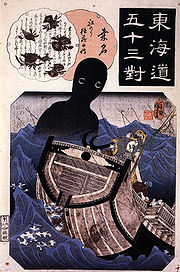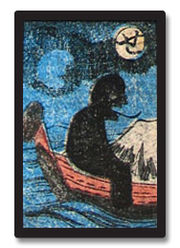
Umibozu
Encyclopedia

Japanese folklore
The folklore of Japan is heavily influenced by both Shinto and Buddhism, the two primary religions in the country. It often involves humorous or bizarre characters and situations and also includes an assortment of supernatural beings, such as bodhisattva, kami , yōkai , yūrei ,...
. The Umibōzu is said to live in the ocean and capsize the ship of anyone who dares speak to it. This spirit's name, which combines the character for "sea" with the character of "Buddhist monk," is possibly related to the fact that the Umibōzu is said to have a large, round head, resembling the shaven heads of Buddhist monks.
Alternatively they are enormous Yōkai
Yōkai
are a class of supernatural monsters in Japanese folklore. The word yōkai is made up of the kanji for "otherworldly" and "weird". Yōkai range eclectically from the malevolent to the mischievous, or occasionally bring good fortune to those who encounter them...
(spectres) that appear to shipwreck victims and fishermen. They are believed to be drowned priests, and exhibit the shaven head and typically appears to be praying. It is usually reported as having a grey, cloud-like torso and serpentine limbs.
According to one story, if angered, they ask that the crews provide a barrel that it proceeds to fill with sea water to drown them. To avoid this disastrous fate, it is necessary to give him a bottomless barrel.

In popular culture
The umibōzu is a very well known yōkai as it is also recognized in modern Japanese culture.- Shigeru MizukiShigeru Mizukiis a Japanese manga author, most known for his Japanese horror manga GeGeGe no Kitaro . A specialist in stories of yōkai, he is considered a master of the genre...
's manga series Gegege no Kitaro features an umibōzu in its cast. - A traditional Umibōzu folktale is told in the second story arc of the anime Mononoke, a sequel to Ayakashi: Samurai Horror Tales, which combined folktales, Kabuki plays, and animated versions of 19th century woodblock art prints to retell classic ghost stories.
- In the anime Lovely ComplexLovely Complex, also known as Lovely Complex, is a romantic comedy shōjo manga by Aya Nakahara. It was published by Shueisha in Bessatsu Margaret from 2001 to 2006 and collected in 17 tankōbon volumes. The series is about the romance between a tall girl and a short boy who are treated as a comedy duo by their...
Umibouzu is the name of a band that the main characters both like. This could relate to their feelings of being alone and having noone to look after them, and so they take refuge in Umibouzu's music. - In the Super SentaiSuper SentaiThe is the name given to the long-running Japanese superhero team genre of shows produced by Toei Co., Ltd., Toei Agency and Bandai, and aired by TV Asahi...
series Ninja Sentai KakurangerNinja Sentai Kakurangerwas TOEI Company Limited's eighteenth production of the Super Sentai television series. The name given to this series by Toei for international distribution is Ninja Rangers....
a Umibōzu appears as a monster and is adapted into the Mighty Morphin Alien RangersMighty Morphin Alien RangersMighty Morphin Alien Rangers is a Power Rangers miniseries set at the end of the third season of Mighty Morphin Power Rangers...
villain "Hydro Hog". - In the manga One Piece, a Umibōzu appears as a minor character in chapter 606 and continues to appear up to the present.

